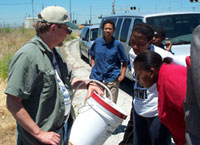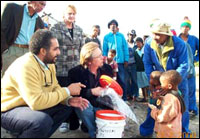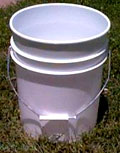The plastic five-gallon bucket is the most humdrum of containers, yet it’s proved to be almost as versatile as duct tape. Creative sorts have turned buckets into toolboxes and ottomans, planters and panniers. And in recent years, some environmental activists have begun using the humble bucket for an even higher purpose: These days, five-gallon buckets may literally be saving lives.

Buckets of fun.
Back in 1994, several years before Erin Brockovich and her boss Edward Masry saw their life stories reenacted on the big screen, Masry was representing a group of citizens from Rodeo, Calif., on the eastern side of San Francisco Bay. His clients lived near a Unocal oil refinery, and they were worried: They’d recently endured a major release of a refinery catalyst called catacarb, which had coated their neighborhoods with sticky goo. Hundreds of them had already gotten sick, and they’d been noticing odd smells around the Unocal site. “We realized there was no way for the people to monitor what was coming out of the refinery,” says Masry.
So Masry inaugurated his own monitoring program. He called up an environmental engineering firm and asked them to redesign the standard air-sampling device — known as a Summa canister, a stainless-steel unit that costs about $2,000 — into a cheap and accurate tool that private citizens could use. The engineers’ solution? The good old five-gallon bucket.
The engineers brought the cost of the sampling unit down to about $250 by housing its guts in an airtight plastic bucket. Once a “grab sample” of air is taken with the bucket, the heavy-duty Tedlar bag inside can be sealed and sent to a lab for analysis. Masry gave 30 buckets to Rodeo citizens, encouraging them to keep tabs on future releases from the Unocal refinery. “The amount of releases dropped dramatically,” he remembers. Two years later, thanks in part to the data collected by refinery neighbors, Unocal settled the citizens’ lawsuit, paying a total of $80 million to the 6,000 residents injured by the catacarb release.

Denny Larson brings out the bucket.
Photo: SAEPEJ.
Denny Larson, then part of a local group called Communities for a Better Environment, saw huge political potential in the engineers’ invention. Larson wanted an even cheaper, simpler version of the bucket, so he and his coworkers started searching for substitute parts at camping stores, boat shops, and vacuum-cleaner dealers. They eventually shaved the cost down to about $75 per unit, and designed a guerrilla environmental monitoring program that included protocols for data collection. Larson started hawking the program to grassroots activists in the Bay Area, and in 1995 his group got a private grant to take their buckets on the road. And thus the Bucket Brigade was born.
Reigning Buckets
Today, there are about 25 Bucket Brigades active in the United States, ranging from California to Philadelphia and Texas to North Carolina. They keep an eye on oil refineries, chemical plants, and even large-scale hog farms. Most are based in “fenceline” neighborhoods — communities located next to industrial sites — and most use the protocols developed by Larson and his coworkers. Each has a team of “sniffers” to detect unusual odors, and a team of samplers to confirm the sniffers’ suspicions via the buckets.
Data gathered by the U.S. EPA confirm that the buckets’ results are comparable to those of the pricey Summa canisters. The data hunted down by sniffers and samplers have never been tested in court — so far, cases involving Bucket Brigades have been settled — but activists say the buckets are an invaluable tool in the court of public opinion.
“We can sit down at a table with [a refinery] and say, ‘We’re going to keep taking samples and keep making you look bad until you do something,'” says Christine Knapp, an organizer for Clean Water Action who works with air samplers in south Philadelphia.

A sampler sets up in Louisiana.
Photo: Louisiana Bucket Brigade.
Anne Rolfes, director of the Louisiana Bucket Brigade, remembers when sampler Dorothy Jenkins of New Sarpy, La., confronted a manager of Orion Refining. “That was one of the great moments of my life,” says Rolfes. “He was so smug and rude, insisting that there wasn’t a problem, and she just slammed her air sample results down on the table and said, ‘Then why did you violate the state benzene standard?'”
Data gathered by Louisiana Bucket Brigade activists recently convinced Shell Chemical to agree to a relocation plan for neighbors of its Norco, La., refinery, Rolfes says. Controversy over the refinery’s practices had been dragging on since the 1970s, and the buckets “reinvigorated the whole campaign,” she says. “People had something to do. In the middle of a [release] event, they could take action.”
The buckets have also spurred federal and state agencies to enforce their own regulations. In Port Arthur, Texas, where the Westside neighborhood is hemmed in by refineries, a trio of dialysis clinics serves a city of fewer than 60,000. “Everyone needs to get their blood washed,” says Hilton Kelley, a Westside native and CEO of the Community Inpower and Development Association. He says publicity surrounding his group’s Bucket Brigade has gotten the attention of the EPA and the Texas Department of Environmental Quality.
For the most part, agencies welcome the supplementary information. Federal law requires industrial sites to estimate their toxic releases each year, and most state and local environmental agencies oversee air-monitoring programs. But a lot of releases still go unreported, and a lot of air goes untested. “The EPA can’t be in everybody’s backyard at the same time,” says Barbara Bates, an air specialist for the agency’s Region 9 laboratory in California. “It’s always useful to have other eyes out there.”
Under the Bush administration, it may be more useful than ever. Recent revisions of the federal Clean Air Act’s New Source Review rules allow refineries and other sites to dodge some anti-pollution measures. The Bush-backed Clear Skies initiative, now making its way through Congress, would establish a trading program for nitrogen oxide, sulfur dioxide, and mercury emissions, while getting rid of several existing Clean Air Act programs.
“It’s a good time for citizens to take up arms and say, ‘Look, once again we realize we have to do this on our own,'” says Denny Larson, now coordinator of the Refinery Reform Campaign.

Larson shows off his bucket of tricks
in South Africa.
Photo: SAEPEJ.
Larson, who some activists call the Johnny Appleseed of the Bucket Brigades, has recently taken his crusade beyond U.S. borders. He’s founded the Global Community Monitor, a two-person shop that’s trained Bucket Brigades in the Philippines, Thailand, and South Africa.
Ardiel Soeker of the South African environmental group Groundwork says local Bucket Brigades have helped bring about new, tougher federal air quality legislation and forced at least one polluting company to begin monitoring — and reducing — its emissions. “The most significant aspect of the … bucket sampling is the power it gives communities,” Soeker noted. “They own the technology and the data produced. They cannot be silenced.”
Larson says he’s seen this power embraced around the world. “People get so excited when they build the bucket, get the test results, and find out what they’re breathing for the first time,” he says. “Man, when they go after companies and regulators, you’d better not be in their way.”


